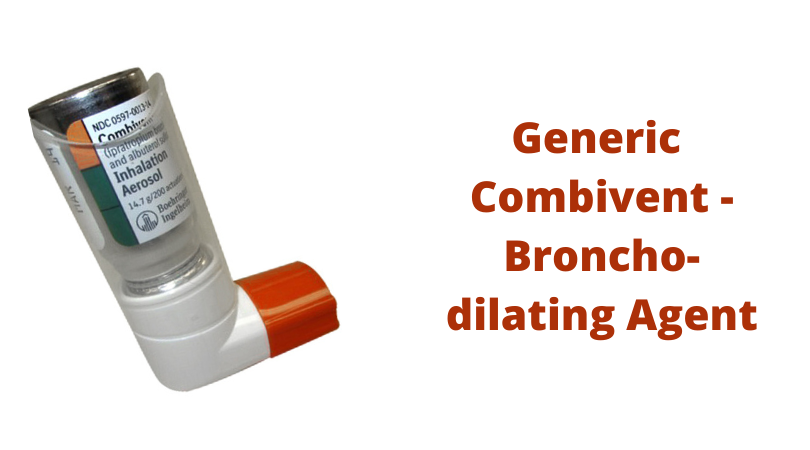Generic Combivent – Bronchodilating Agent
| 50/20mcg 1inhaler |
 |
$40.79 $33.99 $33.99 per inhaler |
+ Package delivery insurance
+ Next orders 10% discount |
ADD TO CART save:$0.00 |
|
| 50/20mcg 3inhalers |
 |
 |
$107.99 $89.99 $30.00 per inhaler |
+ Package delivery insurance
+ Next orders 10% discount |
ADD TO CART save:$11.97 |
| 50/20mcg 6inhalers |
 |
$187.19 $155.99 $26.00 per inhaler |
+ Package delivery insurance
+ Next orders 10% discount |
ADD TO CART save:$47.94 |
 Combivent is a combined bronchodilator drug. Its main ingredients are ipratropium bromide and salbutamol.
Combivent is a combined bronchodilator drug. Its main ingredients are ipratropium bromide and salbutamol.
Main components in details
Ipratropium bromide blocks the m-cholinergic receptors of the smooth muscles of the tracheobronchial tree (mainly large and medium bronchi), inhibits reflex bronchoconstriction, and reduces the secretion of glands in the mucous membrane of the respiratory tract. Structurally similar to the acetylcholine molecule, it is a competitive antagonist. Effectively prevents bronchoconstriction resulting from inhalation of cigarette smoke, cold air, the action of various bronchospasmodic agents, and also eliminates bronchial spasm associated with the influence of n.vagus.
It practically does not have a resorptive effect (it has little effect on heart rate and blood pressure – for the development of tachycardia, inhalation of about 500 doses is necessary). Only 10% of drugs reaches the small bronchi and alveoli, and the rest settles in the pharynx or oral cavity and is swallowed.
Salbutamol in therapeutic doses has a pronounced stimulating effect on the beta2-adrenergic receptors of the bronchi, blood vessels and myometrium. There is no virtually effect on the beta1-adrenergic receptors of the heart. It suppresses the release from mast cells of histamine, leukotrienes and PgD2 and other biologically active substances for a long time. It reduces early and late bronchial reactivity. It has a pronounced bronchodilator effect, preventing or stopping bronchospasm, reduces resistance in the airways. It has a positive effect on mucociliary clearance, stimulates mucus secretion, activates the functions of the ciliated epithelium. It has a number of metabolic effects: it reduces the content of K + in plasma, affects glycogenolysis and insulin secretion, has a hyperglycemic (especially in patients with bronchial asthma) and lipolytic effect, increases the risk of acidosis. In recommended therapeutic doses, it has no negative effect on the central nervous system, does not cause an increase in blood pressure. To a lesser extent, in comparison with drugs of this group, it has a positive chrono- and inotropic effect. It causes expansion of the coronary arteries.
Mode of administration and dosage
Inhalation using nebulizer or a system for non-invasive ventilation of the lungs in the positive airway pressure mode.
Adults, including elderly patients and children over 12 years old – 1 nebula with a sterile solution 3-4 times a day, in the form of inhalation, using a nebulizer. There are no data on the use of the drug in children under 12 years of age.
Pregnancy and lactation
FDA recommendation category – C. It is not recommended to prescribe the drug in the II and III trimesters of pregnancy and during breastfeeding, except in cases when the expected benefit to the mother outweighs any possible risk to the fetus and infant. Combivent is contraindicated in the first trimester of pregnancy.
Side effects
- The respiratory system: irritation of the bronchi; possible – nasal congestion, stridor, paradoxical bronchospasm.
- The digestive system: nausea, less often – dry mouth or drooling, taste perversion, diarrhea, vomiting.
- The nervous system: headache, less often – dizziness, excessive fatigue, nervousness, paresthesia, tremor, insomnia; potentially possible – impaired coordination of movements, weakness.
- The CVS: increased blood pressure, less often – tachycardia, cardialgia; a decrease in blood pressure is possible.
- The urinary system: dysuria.
- The organs of senses: if it gets into the eyes, an increase in intraocular pressure is possible – acute pain in the eye, impaired visual acuity, injection of the sclera, conjunctival hyperemia.
- Allergic reactions: angioneurotic edema of the tongue, lips, face, skin rash (including urticaria, up to giant), laryngospasm, bronchospasm, itching.
- Others: dysphonia, arthralgia, alopecia.
Overdose symptoms
Combivent overdose symptoms are headache, nausea, vomiting, irritability, tachycardia, angina pectoris, hypoxemia, acidosis, hypokalemia, hyperglycemia, muscle tremor, hallucinations, ventricular flutter, cardiac arrest, death.
Symptomatic treatment is prescribed (including the introduction of cardioselective beta-blockers).
Combinations of this asthma inhaler
- Combivent enhances the bronchodilator effect of beta-adrenostimulants and xanthine derivatives (theophylline).
- It also strengthens the effect of central nervous system stimulants, cardiotropy of thyroid hormones.
- It increases the likelihood of glycosidic intoxication.
- It reduces the effectiveness of antihypertensive drugs, nitrates.
- Theophylline and other xanthines increase the likelihood of developing tachyarrhythmias, drugs for inhalation anesthesia and levodopa – severe ventricular arrhythmias.
- MAO inhibitors and tricyclic antidepressants enhance the effect of salbutamol, can lead to a sharp decrease in blood pressure.
- Anticholinergic drugs increase the risk of high intraocular pressure.
- Diuretics and GCS enhance the hypokalemic effect of salbutamol.

